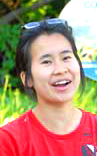Common menu bar links
.jpg)
The story of Paw:
Escaping the military dictators of Myanmar
 Paw’s father had been a public servant in Burma (also known as Myanmar). But after the military took power, he was forced to flee to a refugee camp on the Thai-Burma border in 1989 because he was pro-democracy and a member of the Karen, a persecuted ethnic minority. Paw, her mother and sisters were finally able to join their father in the camp five years later.
Paw’s father had been a public servant in Burma (also known as Myanmar). But after the military took power, he was forced to flee to a refugee camp on the Thai-Burma border in 1989 because he was pro-democracy and a member of the Karen, a persecuted ethnic minority. Paw, her mother and sisters were finally able to join their father in the camp five years later.
Paw completed high school in the refugee camp and attended a one-year, pre-college program sponsored by an NGO in Thailand, where she first learned English. In 2003, she was sponsored to come to Canada by the University of Toronto Students Administrative Council through World University Services Canada (WUSC).
When Paw first arrived in Toronto, the transition from her life in a camp in the jungle to the congestion and traffic in a big city threw her into culture shock. Snow was a totally new experience. It took her quite a while to adjust. Fortunately, she received lot of help and services from student volunteer committees.
Paw has been studying, working and volunteering in Toronto since her arrival in 2003. She is completing her Honours Bachelor of Arts. She currently works as an interpreter for Karen refugees who have recently arrived in Toronto. On May 24, 2007, Paw became a Canadian citizen.
Paw has recently been reunited with her family. Her family arrived in Canada on May 2, 2007, as government-sponsored refugees. Paw’s mother and father, twin sister, along with her brother and his wife, recently attended her citizenship ceremony.
“I am really thankful and proud to be a Canadian citizen,” says Paw. “I really thank the Canadian government for opening the opportunity for refugee people from Thai-Burma border areas like my family to continue their lives as full human beings.”
Burma (also known as Myanmar)
Some 140,000 refugees from Burma’s nine main minority groups have been living in nine isolated and closed camps on the Thai/Burmese border for up to 20 years, the largest refugee population in Southeast Asia. Following an agreement in 2005 with the Royal Thai Government to allow large-scale resettlement of Burmese refugees, the UNHCR has identified vulnerable segments of the Karen population as being in need of priority resettlement.
There are nearly 50 million people living in Burma, a country richly endowed with resources, oil and gas, gemstones and huge areas of fertile land. Once called “the rice bowl of Asia,” Burma is now ranked as one of the world’s ten poorest countries.
